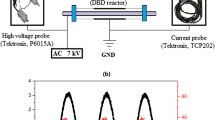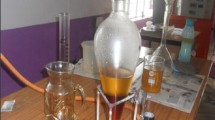Abstract
The exhaust emissions from the compression ignition engines are harmful to both human beings and the environment. After-treatment devices placed in the exhaust are designed to reduce these emissions. These devices have significant conversion efficiency but have various drawbacks such as the cost and availability of the precious catalyst for catalytic converters. In this work, an emission reduction setup was developed that can reduce NO, HC, CO and smoke simultaneously. The emission reduction setup is based on the concept of an electrostatic precipitator (ESP) and plasma generation by corona discharge technique. Both diesel and waste cooking oil biodiesel (WCO) were separately used for the test. The results show that HC emissions at full load with ESP system reduced from 0.71 to 0.27 g/kWh for diesel and for WCO it reduced from 0.81 to 0.31 g/kWh. Similarly, the CO emissions reduced from 1.50 to 0.6 g/kWh for diesel and from 1.95 to 0.92 g/kWh for WCO. The smoke emission and NO emission were also reduced by 30.86 and 29.3% for diesel and WCO and 17 and 18% for diesel and WCO, respectively. However, the carbon dioxide emissions were found to increase as the HC and CO generated were also converted to CO2. The study shows that the emission reduction setup can effectively reduce the emissions without any effect on the engine performance.









Similar content being viewed by others
References
Arslan R, Ulusoy Y (2018) Utilization of waste cooking oil as an alternative fuel for Turkey. Environ Sci Pollut Res 25(25):24520–24525. https://doi.org/10.1007/s11356-017-8899-3
Boopathi D, Thiyagarajan S, Edwin Geo V, Madhankumar S, Gheith R (2018) Effect of geraniol on performance, emission and combustion characteristics of CI engine fuelled with gutter oil obtained from different sources. Energy 157:391–401. https://doi.org/10.1016/J.ENERGY.2018.05.129
Chang JS, Urashima K, Arquilla M, Ito T (1998) Reduction of NOx from combustion flue gases by corona discharge activated methane radical injections. Combust Sci Technol 133(1–3):31–47. https://doi.org/10.1080/00102209808952025
Edwin Geo V, Sonthalia A, Nagarajan G, Nagalingam B, Aloui F (2019) Effect of port premixed liquefied petroleum gas on the engine characteristics. J Energy Resour Technol 141(11). https://doi.org/10.1115/1.4043698
Geo VE, Sonthalia A, Nagarajan G, Nagalingam B (2017) Studies on performance, combustion and emission of a single cylinder diesel engine fuelled with rubber seed oil and its biodiesel along with ethanol as injected fuel. Fuel 209:733–741. https://doi.org/10.1016/j.fuel.2017.08.036
Geo VE, Sonthalia A, Aloui F, Femilda Josephin JS (2018) Study of engine performance, emission and combustion characteristics fueled with diesel-like fuel produced from waste engine oil and waste plastics. Front Environ Sci Eng 12(4):8–9. https://doi.org/10.1007/s11783-018-1063-6
Herling D, Smith M, Baskaran S, Kupe J (2000) Application of non-thermal plasma assisted catalyst technology for diesel emission reduction. SAE Technical Paper Series 2000-01–3088. https://doi.org/10.4271/2000-01-3088
Huang Y, Huang S, Zheng Q, Shen X, Wang S, Han P et al (2015) Recent progress of dry electrostatic precipitation for PM2.5 emission control from coal-fired boilers. International Journal of Plasma Environmental Science and Technology 9(2):69–126
Ji J-H, Hwang J, Bae G-N, Kim Y-G (2004) Particle charging and agglomeration in DC and AC electric fields. J Electrost 61(1):57–68. https://doi.org/10.1016/j.elstat.2003.12.003
Kanazawa S, Chang JS, Round GF, Sheng G, Ohkubo T, Nomoto Y, Adachi T (1997) Removal of NOx from flue gas by corona discharge activated methane radical showers. J Electrost 40–41:651–656. https://doi.org/10.1016/S0304-3886(97)00072-7
Kinoshita K (2002) Study on removal of PM and NOx in diesel exhaust by using DC corona discharge. SAE Technical Paper 2002-01–16(724). https://doi.org/10.4271/2002-01-1660
Kuwahara T, Nishii S, Kuroki T, Okubo M (2013) Complete regeneration characteristics of diesel particulate filter using ozone injection. Appl Energy 111:652–656. https://doi.org/10.1016/J.APENERGY.2013.05.041
Li X, Yang L, Lei Y, Wang J, Lu Y (2000) A method for removal of CO from exhaust gas using pulsed corona discharge. J Air Waste Manag Assoc 50(10):1734–1738. https://doi.org/10.1080/10473289.2000.10464215
Losacco C, Perillo A (2018) Particulate matter air pollution and respiratory impact on humans and animals. Environ Sci Pollut Res 25(34):33901–33910. https://doi.org/10.1007/s11356-018-3344-9
Nakajima Y, Sato T (2003) Electrostatic collection of submicron particles with the aid of electrostatic agglomeration promoted by particle vibration. Powder Technol 135–136:266–284. https://doi.org/10.1016/S0032-5910(03)00165-7
Nguyen Huu Nhon Y, Mohamed Magan H, Petit C (2004) Catalytic diesel particulate filter: evaluation of parameters for laboratory studies. Appl Catal B Environ 49(2):127–133. https://doi.org/10.1016/J.APCATB.2003.12.005
Nishida M, Yukimura K, Kambara S, Maruyama T (2001) Reduction of nitrogen oxide in N2 by NH3 using intermittent dielectric barrier discharge. J Appl Phys 90(6):2672–2677. https://doi.org/10.1063/1.1394902
Okubo M, Arita N, Kuroki T, Yoshida K, Yamamoto T (2008) Total diesel emission control technology using ozone injection and plasma desorption. Plasma Chem Plasma Process 28(2):173–187. https://doi.org/10.1007/s11090-008-9121-7
Parker KR (1997) Milestones in the history of precipitation. In: Parker KR (ed) Applied electrostatic precipitation. Blackie Acad.. & Professional, London, pp 11–12
Penetrante BM, Brusasco RM, Merritt BT, Pitz WJ, Vogtlin GE (1998) Plasma-assisted catalytic reduction of NOx. SAE Technical Paper Series 982508
Puchkarev V, Kharlov A, Gundersen M, Roth G (1999) Application of pulsed corona discharge to diesel exhaust remediation. Digest of Technical Papers. 12th IEEE International Pulsed Power Conference. (Cat. No.99CH36358) 1(October):511–514. https://doi.org/10.1109/PPC.1999.825522
Ryu J, Jeong D, Chun B, Lee D, Lee K, Lee H, Chun KM (2002) Experimental study on DeNOx performance by plasma-catalyst (Ag, Au/Al2O3) system. SAE International (2002-01–2705)
Sano K, Yoshioka Y (2003) Effect of oxygen injection and HC addition on NO removability of ozone injection method. IEEJ Trans Fundam Mater 123(10):1030–1036. https://doi.org/10.1541/ieejfms.123.1030
Sato S, Kawada Y, Sato S, Hosoya M (2011) The study of NOx reduction using plasma-assisted SCR system for a heavy duty diesel engine. SAE International (2011-01–0310). https://doi.org/10.4271/2011-01-0310
Senthil Kumar M, Jaikumar M (2014) A comprehensive study on performance, emission and combustion behavior of a compression ignition engine fuelled with WCO (waste cooking oil) emulsion as fuel. J Energy Inst 87(3):263–271. https://doi.org/10.1016/j.joei.2014.03.001
Stratakis GA, Psarianos DL, Stamatelos AM (2002) Experimental investigation of the pressure drop in porous ceramic diesel particulate filters. Journal of Automobile Engineering 216:773–784
Subramaniam MK, Pachamuthu S, Arulanandan J, Muthiya J (2016) Simultaneous reduction of HC, NOx and PM by using active regeneration technique. SAE International 2016-01–0912
Subramanian T, Varuvel EG, Martin LJ, Beddhannan N (2017) Effect of lower and higher alcohol fuel synergies in biofuel blends and exhaust treatment system on emissions from CI engine. Environ Sci Pollut Res 24(32):25103–25113. https://doi.org/10.1007/s11356-017-0214-9
Sudrajad A, Yusof AF (2015) Review of electrostatic precipitator device for reduce of diesel engine particulate matter. Energy Procedia 68:370–380. https://doi.org/10.1016/j.egypro.2015.03.268
Talebizadeh P, Babaie M, Brown R, Rahimzadeh H, Ristovski Z, Arai M (2014) The role of non-thermal plasma technique in NOx treatment: a review. Renew Sust Energ Rev 40(x):886–901. https://doi.org/10.1016/j.rser.2014.07.194
Thiyagarajan S., Geo VE, Martin LJ, Nagalingam B (2018a) Combined effect of fuel-design and after-treatment system on reduction of local and global emissions from CI engine. Environmental Technology (United Kingdom) 1–11. https://doi.org/10.1080/09593330.2018.1453871
Thiyagarajan S, Varuvel EG, Martin LJ, Beddhannan N, Geo VE, Martin LJ, Nagalingam B (2018b) Mitigation of carbon footprints through a blend of biofuels and oxygenates, combined with post-combustion capture system in a single cylinder CI engine. Renew Energy 130:1067–1081. https://doi.org/10.1016/j.renene.2018.07.010
Thiyagarajan S, Sonthalia A, Edwin Geo V, Ashok B, Nanthagopal K, Karthickeyan V, Dhinesh B (2019) Effect of electromagnet-based fuel-reforming system on high-viscous and low-viscous biofuel fueled in heavy-duty CI engine. J Therm Anal Calorim 138(1):633–644. https://doi.org/10.1007/s10973-019-08123-w
Thomas SE, Shawcross JT, Gillespie R, Raybone D, Martin AR (2001) The role of NO selective catalysts in the plasma enhanced removal of NOx and PM from diesel exhaust. Sae Technical Paper Series 724:2001–3568. https://doi.org/10.4271/2001-01-3568
Thonglek N, Dechthummarong C, Kiatsiriroat T (2011) Soot treatment by using high voltage pulse energized electrostatic precipitator. Energy Procedia 9:292–298. https://doi.org/10.1016/J.EGYPRO.2011.09.031
Tonkyn RG, Barlow SE, Hoard JW (2003) Reduction of NOx in synthetic diesel exhaust via two-step plasma-catalysis treatment. Appl Catal B Environ 40(3):207–217. https://doi.org/10.1016/S0926-3373(02)00150-9
Tran DN, Aardahl CL, Rappe KG, Park PW, Boyer CL (2004) Reduction of NOx by plasma-facilitated catalysis over In-doped γ-alumina. Appl Catal B Environ 48(2):155–164. https://doi.org/10.1016/j.apcatb.2003.10.008
Ueda M, Itoh Y, Shinjoh H, Nakakita K, Arakawa M (2004) A concept of plasma assisted catalyst system using a DeNOx catalyst for an automobile diesel engine. SAE Technical Papers 724. https://doi.org/10.4271/2004-01-1834
Umemoto H, Hayashi H, Takashima K, Mizuno A (2008) Electrostatic precipitators for cleaning diesel exhaust. In 2008 IEEE Industry Applications Society Annual Meeting (pp. 1–4). https://doi.org/10.1109/08IAS.2008.97
Varuvel EG, Sonthalia A, Subramanian T, Aloui F (2018a) NOx-smoke trade-off characteristics of minor vegetable oil blends synergy with oxygenate in a commercial CI engine. Environ Sci Pollut Res 25(35):35715–35724. https://doi.org/10.1007/s11356-018-3484-y
Varuvel EG, Sonthalia A, Subramanian T, Aloui F (2018b) NOx-smoke tradeoff characteristics of minor vegetable oil blends synergy with oxygenate in a commercial CI engine. Environ Sci Pollut Res 25(35):35715–35724
Zukeran A, Ikeda Y, Ehara Y, Ito T, Takahashi T, Kawakami H, Takamatsu T (2000) Agglomeration of particles by ac corona discharge. Electrical Engineering in Japan 130(1):30–37. https://doi.org/10.1002/(SICI)1520-6416(200001)130:1<30::AID-EEJ5>3.0.CO;2-F
Acknowledgements
The authors are thankful to Dr. B. P. Kiran from Synthesis with Catalysts Pvt. Ltd. for providing the catalyst.
Author information
Authors and Affiliations
Corresponding author
Additional information
Responsible Editor: Philippe Garrigues
Publisher’s note
Springer Nature remains neutral with regard to jurisdictional claims in published maps and institutional affiliations.
Appendix 1
Appendix 1
Sample calculation for the uncertainty analysis
Uncertainty in brake power = \( \sqrt{{\left(\frac{\Delta V}{V}\right)}^2+{\left(\frac{\Delta I}{I}\right)}^2} \) = 1.2%
Uncertainty in fuel consumption = \( \sqrt{{\left(\frac{\Delta A}{A}\right)}^2+{\left(\frac{\Delta t}{t}\right)}^2} \) = 1.5%
Uncertainty in brake thermal efficiency =\( \sqrt{{\left(\frac{\Delta \mathrm{BP}}{\mathrm{BP}}\right)}^2+{\left(\frac{\Delta \mathrm{FC}}{\mathrm{FC}}\right)}^2} \) = 1.12%
Uncertainty in oxides of nitrogen =\( \sqrt{{\left(\frac{\Delta \mathrm{BP}}{\mathrm{BP}}\right)}^2+{\left(\frac{\Delta \mathrm{NO}}{\mathrm{NO}}\right)}^2} \) = 1.1%
Uncertainty in carbon monoxide =\( \sqrt{{\left(\frac{\Delta \mathrm{BP}}{\mathrm{BP}}\right)}^2+{\left(\frac{\Delta \mathrm{CO}}{\mathrm{CO}}\right)}^2} \) = 1.12%
Uncertainty in unburnt hydrocarbon =\( \sqrt{{\left(\frac{\Delta \mathrm{BP}}{\mathrm{BP}}\right)}^2+{\left(\frac{\Delta \mathrm{HC}}{\mathrm{HC}}\right)}^2} \) = 1.14%
Uncertainty in carbon dioxide =\( \sqrt{{\left(\frac{\Delta \mathrm{BP}}{\mathrm{BP}}\right)}^2+{\left(\frac{\Delta {\mathrm{CO}}_2}{{\mathrm{CO}}_2}\right)}^2} \) = 1.15%
Uncertainty in smoke = 1.0%
Where V—the voltage available from the generator, I—the current available from the generator, A—graduated burette, t—time, BP—brake power, FC—fuel consumption, NO—oxides of nitrogen, CO—carbon monoxide, HC—unburnt hydrocarbon, and CO2—carbon dioxide.
Rights and permissions
About this article
Cite this article
Sonthalia, A., Garg, S., Sharma, R. et al. Effect of electrostatic precipitator on exhaust emissions in biodiesel fuelled CI engine. Environ Sci Pollut Res 28, 11850–11859 (2021). https://doi.org/10.1007/s11356-019-07359-1
Received:
Accepted:
Published:
Issue Date:
DOI: https://doi.org/10.1007/s11356-019-07359-1




